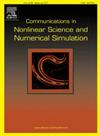复杂多尺度非线性系统动力学的物理洞察:快速和慢速变量的识别
IF 3.4
2区 数学
Q1 MATHEMATICS, APPLIED
Communications in Nonlinear Science and Numerical Simulation
Pub Date : 2025-04-23
DOI:10.1016/j.cnsns.2025.108858
引用次数: 0
摘要
在许多由非线性动力系统控制的应用中,模型是在一个向量空间的标准(自然)基础上引入的,但是使用一组不同的基向量来分析这个模型更自然,这更适合于获得相关的物理见解。这里考虑了多尺度动力系统的情况,其中适当的备选基向量集是分解切空间的基向量集。引入了简单的算法工具来识别快速和慢速变量,从而促进(i)简化模型的构建和(ii)设计用于控制跨不同科学学科的复杂多尺度系统的新途径。这些工具的有用性在两个著名的多尺度模型中得到了证明:Michaelis-Menten模型和Lorenz模型。本文章由计算机程序翻译,如有差异,请以英文原文为准。
Physical insights from complex multiscale non-linear system dynamics: Identification of fast and slow variables
There are many applications governed by nonlinear dynamical systems in which the model is introduced in a standard (natural) basis of a vector space, but it is more natural to analyze this model using a different set of basis vectors, which is more suitable for the acquisition of the relevant physical insights. Here the case of multiscale dynamical systems is considered, for which the appropriate alternative set of basis vectors is the one resolving the tangent space. Simple algorithmic tools are introduced that identify the fast and slow variables, thus facilitating (i) the construction of reduced models and (ii) the design of novel pathways for controlling complex multiscale systems across diverse scientific disciplines. The usefulness of these tools is demonstrated in two well-known multiscale models: the Michaelis–Menten and the Lorenz models.
求助全文
通过发布文献求助,成功后即可免费获取论文全文。
去求助
来源期刊

Communications in Nonlinear Science and Numerical Simulation
MATHEMATICS, APPLIED-MATHEMATICS, INTERDISCIPLINARY APPLICATIONS
CiteScore
6.80
自引率
7.70%
发文量
378
审稿时长
78 days
期刊介绍:
The journal publishes original research findings on experimental observation, mathematical modeling, theoretical analysis and numerical simulation, for more accurate description, better prediction or novel application, of nonlinear phenomena in science and engineering. It offers a venue for researchers to make rapid exchange of ideas and techniques in nonlinear science and complexity.
The submission of manuscripts with cross-disciplinary approaches in nonlinear science and complexity is particularly encouraged.
Topics of interest:
Nonlinear differential or delay equations, Lie group analysis and asymptotic methods, Discontinuous systems, Fractals, Fractional calculus and dynamics, Nonlinear effects in quantum mechanics, Nonlinear stochastic processes, Experimental nonlinear science, Time-series and signal analysis, Computational methods and simulations in nonlinear science and engineering, Control of dynamical systems, Synchronization, Lyapunov analysis, High-dimensional chaos and turbulence, Chaos in Hamiltonian systems, Integrable systems and solitons, Collective behavior in many-body systems, Biological physics and networks, Nonlinear mechanical systems, Complex systems and complexity.
No length limitation for contributions is set, but only concisely written manuscripts are published. Brief papers are published on the basis of Rapid Communications. Discussions of previously published papers are welcome.
 求助内容:
求助内容: 应助结果提醒方式:
应助结果提醒方式:


